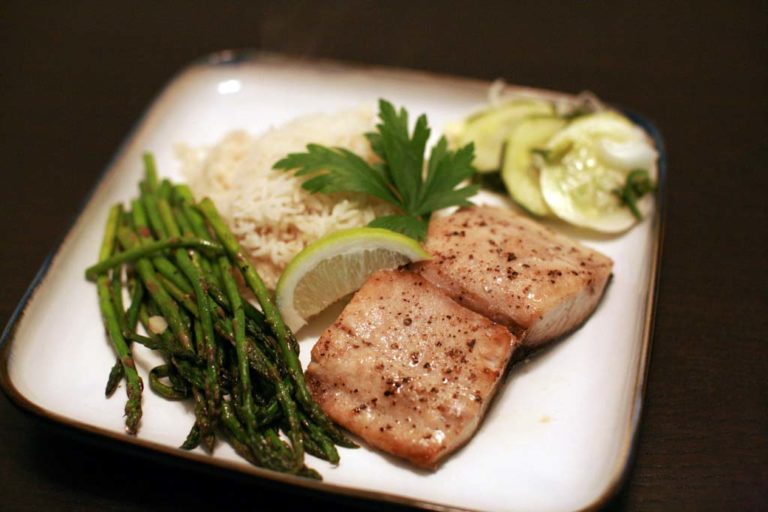
Chef's notes:
Mahi-mahi has become a very popular fish in the United States. Visitors to Hawaii and the Caribbean have been eating this fish for decades, and eventually word of this exotic fish with a taste somewhere between cod and flounder made its way to mainland America. Demand increased, and now it can be found fresh from your local butcher. Mahi-mahi has several other common names: dorado, rakingo, calitos, maverikos, lampuka and, most notably, dolphin fish. The dolphin fish is a fish, and is not related to the “dolphin,” which is a mammal.
Mahi-mahi has a very mild fish flavor similar to other whitefish, such as flounder and tilapia. Which Americans love: fish that doesn’t taste like fish. It requires no sauce and little seasoning; simple salt and pepper will do. And if this fish is prepared correctly, it is tender and almost creamy—like it was soaked in butter.
Ingredients
- 1 # sashimi-grade mahi-mahi
- sea salt
- black pepper
- vegetable oil
Mahi-Mahi Fillet: Seasoned Simply with Sea Salt and Broiled Quickly in a Hot Oven
- Purchase some fresh mahi-mahi from your local butcher or grocery store. In most cases it is okay if it has been “previously frozen.” In all likelihood, it was flash-frozen, which minutely affects the quality. It will be a good idea to cook the fish on the date of purchase. Even though it may be edible for 3-4 days, it will taste better the sooner you eat it.
- Season the fillet of mahi-mahi with salt and pepper. It is best to use a non-iodized salt like kosher, sea salt, sel gris or fleur de sel. For the pepper portion, black pepper will taste fine, but you may try white pepper for a little different flavor. Plus, white pepper won’t stand out as much as black. After seasoning the fillets, rub them with a little vegetable oil. Don’t use olive oil, as it may burn and leave a black residue.
- If your fillet of mahi-mahi has skin on one side, you will want to cut slits through to help with the cooking on that side. Also, you will now be able to season the meat a little on that side. It will be difficult to get through the scales and skin without a sharp knife, so sharpen your knife. A bread knife may work, but you may find it a crude substitute for a sharp chef’s knife.
- Depending on the size of your fillet of mahi-mahi, you may have to cut it into portions. It may seem easier to cook it as one large piece, but the result of flipping a large piece of hot, juicy fish is something to avoid. Cut through the fleshy side with the skin down, once again using a sharp knife.
- Heat a broiler for a few minutes before putting your mahi-mahi under it. An electric broiler will take at least 10 minutes to heat up. A gas broiler will be up to temp in as few as five minutes. You are only interested in the direct heat—think inverted grill—so it is okay to leave the oven door open a crack to see how the mahi-mahi is cooking. Broilers do take some time to get used to. Put the fillets under the elements on a broiling pan, skin up.
- After a few minutes, the skin should be crackling and bubbling a little. Once the edges begin to brown a little, pull your rack out and flip the fillets with a pair of spring-loaded tongs. Check the broiler to make sure that it is still red-hot.
- Push the rack back under the broiler, making sure your fillets are beneath the heat source as evenly as possible. You may confidently leave them alone for a couple minutes. But you will want to check them as you get used to the wattage or BTU output of your broiler.
- As your mahi-mahi cooks under the broiler, watch to see how it browns. You may brown it to your liking, but you will want to check the internal temperature of the mahi-mahi at some point. If you purchased sushi-grade or sashimi mahi-mahi, you don’t have to worry about undercooked fish, since it is approved for raw consumption. But if you didn’t, use a digital thermometer to check the internal temperature of your fish.
Tips & Tricks
- Some broilers will switch off if they get too hot. This is not something you want. Leaving the door open helps to keep the broiler from turning off, by keeping the temperature down. But since a broiler provides plenty of direct heat when at full blast, it will not affect the finished product. It is similar to grilling with the lid up, as opposed to down.
- Many recipes for Mahi-mahi are far too complex. Mahi-mahi has a very delicate but tremendous flavor that disappears easily when too many things are added. I urge you to simply salt and pepper this fish when you cook it. You will be rewarded with amazing flavor.
